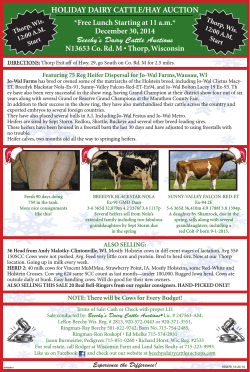
seroprevalence of neospora caninum in dairy cows with
LUCRĂRI ŞTIINŢIFICE MEDICINĂ VETERINARĂ VOL. XLV(3), 2012, TIMIŞOARA SEROPREVALENCE OF NEOSPORA CANINUM IN DAIRY COWS WITH REPRODUCTIVE DISORDERS IN VOJVODINA PROVINCE, SERBIA 1 2 2 2 M. SAVOVIŠ , VESNA LALOŠEVIŠ , S. SIMIN , LJILJANA PAVIŢIŠ , 2 S. BOBOŠ 1 PVS „MSV Medicus D.O.O.―, Milice Stojadinović Srpkinje No. 1, 21209, Bukovac, Serbia 2 Faculty of Agriculture, Department for Veterinary Medicine, Novi Sad, Serbia E-mail: msvmedicus@gmail.com Summary Neospora caninum, a causative agent of neosporosis is obligate intra-cellular protozoa recognised all over the world as a major cause of abortions and other reproductive disorders in cattle. With regard to the lack of sufficient epizootiological data on this parasite in Serbia, the aim of our study was to asses the seroprevalence to N.caninum in dairy cows with reported reproductive disorders in Vojvodina, northern province of the country. Total of 52 dairy cows with various reproductive disorders were sampled during 2011 and 2012. Collected sera were diluted in phosphate-buffered saline (PBS; pH=7.4) to 1:200 (cut off value) and examined using commercial slides for indirect immunofluorescence antibody test (IFAT) (VMRD Inc, USA). Positive samples were further titrated using two-fold serial dilutions to determine the highest titer. Cows were classified in two groups: cows with abortion (AB group) and without abortion (WAB group). Statistical analysis was performed in Quantitative Parasitology 3.0 free software. The overall seroprevalence of N. caninum in dairy cows with reproductive disorders was 17.3% (9/52, CI 95: 9.1% - 29.7%). Antibodies were detected in three out of twelve aborting cows (AB group: 18.8%, CI 95: 5.3% - 43.6%) and in six out of forty animals without abortions (WAB group: 16.7%, CI 95: 7.5% - 32.0%). Statistical analysis of the results obtained in our study showed no significant difference between seroprevalences of AB group and WAB group (p=1.000). Antibody levels in seropositive animals ranged from 1:200 to 1:1600, with the highest level recorded in one cow from AB group. Although further investigations, which would exclude other abortifacient agents and involve histopathological examination of aborted foetuses, are needed, results of our study suggest reasonable doubt that N. caninum could be one of the major causes of abortions and other reproductive disorders in dairy cattle from Vojvodina. Key words: Neospora caninum, seroprevalence, reproductive disorders, dairy cows, Serbia Neospora caninum, a causative agent of neosporosis is an obligate intracellular protozoa which is proved to invade a wide range of domestic and wild animals (8, 5, 1, 20). Canids act as definitive hosts of N. caninum, and herbivores are recognized as its intermediate host. The most affected domestic animals are dogs 161 LUCRĂRI ŞTIINŢIFICE MEDICINĂ VETERINARĂ VOL. XLV(3), 2012, TIMIŞOARA and cattle, in which parasite may cause serious neuromuscular illness and various reproductive disorders, respectively. All over the world, N. caninum impacts today's livestock industry since it has been recognised as a major cause of abortions and other reproductive disorders in cattle leading to serious economic losses in terms of abortion, increased culling of seropositive animals and reduced milk production on the one hand (17, 6). To our knowledge, there are some data about bovine neosporosis in Serbia, obtained by Lalošević et al. (unpublished) and Vidić et al. (25), both conducted in Vojvodina, the northern province of the country. Still, with regard to the lack of sufficient epizootiological data, the aim of this study was to assess the seroprevalence of this parasite in dairy cows with reproductive disorders in Vojvodina. Materials and methods Total of 52 dairy cows with various reproductive disorders were sampled during 2011 and 2012. Blood samples were collected by jugular venipuncture and sent, immediately, to the laboratory where they were centrifuged. After separation, sera were frozen at -20°C until examination. Reproductive history data related to various disorders was recorded for each cow. Since the abortion is the leading symptom of bovine neosporosis, cows were classified in two groups: cows with abortion (AB group) and without abortion (WAB group). The latter group includes animals with other reproductive disorders. The presence of N.caninum antibodies was determined using commercial slides for indirect immunofluorescence antibody test (IFAT) (VMRD Inc, USA). Sera were diluted in phosphate-buffered saline (PBS; pH=7.4) to 1:200 (cut off value), and samples showing whole tachyzoite fluorescence were considered positive. Those samples were further titrated using two-fold serial dilutions to determine the highest titer. The end point titer was the last serum dilution showing distinct and whole parasite fluoresecence. Statistical analysis was performed in Quantitative Parasitology 3.0 free software (19). Prevalences in AB and WAB group were compared with two sided Fisher's exact test at confidece level 95%. Results and discussions The overall seroprevalence of N. caninum in dairy cows with reproductive disorders was 17.3% (9/52, CI 95: 9.1% - 29.7%). Antibodies were detected in three out of twelve aborting cows (AB group: 18.8%, CI 95: 5.3% - 43.6%) and in six out of forty animals without abortions (WAB group: 16.7%, CI 95: 7.5% 32.0%). Statistical analysis of the results obtained in our study showed no significant difference between seroprevalences of AB group and WAB group 162 LUCRĂRI ŞTIINŢIFICE MEDICINĂ VETERINARĂ VOL. XLV(3), 2012, TIMIŞOARA (p=1.000, two sided Fisher´s exact test). Antibody levels in seropositive animals ranged from 1:200 to 1:1600, with the highest level recorded in one cow from AB group. Overall seroprevalence of N. caninum in cows with reproductive disorders obtained in our research was similar to prevalence in herds from Brazil (15) and Slovakia (20), where researcher found about 20% seropositive cows with history of reproductive disorders in both studies. Investigators from different countries report various prevalence of N. caninum in aborting cows, which ranges from 18% in UK (2), 29.3% in Western Romania (11) to 34% and 57% in aborting cows from Argentina (report in beef cattle) and Mexico, respectively (16, 7). Results from AB group obtained in our research coincide with prevalence in UK (2), showing lower level in aborting dams than in Argentina and Mexico (16, 7). Nine out of 12 aborting cows in our research were negative to N. caninum antibodies. The lack of association between history of abortions and Neospora - antibodies in those cows might be considered as a consequence of several factors, including tendency of cattle to change their serostatus during their life (21, 3, 4) as well as high genetic and biological diversity of field isolates of N. caninum and variability in cow’s immunity (11). In other words, aborting animals may seem seronegative not because of the lack of N. caninum specific antibodies, but because the antibodies have fallen below the cut off levels of the commonly used serological assays (6). The other reason for low number of seropositive aborting dams could be low pathogenicity of the field isolate that is capable of causing other reproductive losses, such are foetal death with resorption, stilbirths, birth of deformed calves and calves manifesting neuromuscular syndrome (10), but not to cause sufficient damage to the developing foetus and its placenta to trigger abortion. (9, 3). Also, it is well known that in the majority of cases N. caninum infection is asymptomatic, resulting in the birth of clinically normal but chronically infected calves (9, 10). Finally, we couldn't exclude other abortifacient agents which may have caused abortions in these animals, Considering antibody levels, the highest titer in our study was 1:1600 (one cow) while in dams with reproductive loses in Argentina antibody levels were up to 1:3200 and higher (16). Still, majority of animals in both studies had titers 1:200 and 1:400. This finding is, however, opposite to the finding of Václavek et al. (24) and Kashiwazaki et al. (13) who reported that seropositive cows with higher titres were more prone to abortions then the ones with low titres. Since diagnosis of bovine neosporosis should, whenever it is possible, be based both on direct, postmortem approach (e.g. histopathology, immunohistochemistry, PCR) and indirect, in vivo methods (e.g. IFAT, DAT, WB and several ELISA assays) (17), further investigations, directed towards confirmation of causative agent in aborted foetuses, are needed to confirm N. caninum as a definitive cause of abortion in cattle from Vojvodina. Having in mind that up to 90% of calves born from infected dams are also Neospora positive (22, 10), monitoring of antibodies, which are an indicator of the exposure of the animal 163 LUCRĂRI ŞTIINŢIFICE MEDICINĂ VETERINARĂ VOL. XLV(3), 2012, TIMIŞOARA to the parasite (8), is vital to prevent reproductive loses in cows. Many authors (24, 10, 14) found strong association between seropositivity and abortion, reporting that seropositive cows were 8 to 13 times more likely to abort then the seronegative ones while others (23, 10, 12) reported that cows from their studies which turned out to be Neospora positive required more inseminations to establish conception. The results obtained in this work strongly indicate the importance of neosporosis in our dairy cattle as a possible factor of economic losses and a great need for Neospora control programmes. Beside the right combination of control measures that should be conducted at the herd level (e.g. screening of imported cattle, culling of seropositive cows, etc.) extra precaution should be devoted to controlling the local dog population and restricting their access to the cattle feeds, especially since Neospora antibodies have been previously reported in dogs from Vojvodina, with determined prevalence of 12.9% (18). Conclusions N. caninum antibodies were detected, using IFAT technique, in the dairy cattle from Vojvodina with history of various reproductive disorders, with overall prevalence of 17.3% In the group of aborting cows prevalence was 18.8% while in the group of cows with other reproductive disorders a slightly lower prevalence was found (16.7%) No significant difference was found between seroprevalences of aborting and non-aborting group (p=1.000) In Serbia, further investigations are needed to confirm N. caninum as abortifacient in fetuses, to monitor prevalence in cattle and dogs for update of epidemiology and for successful control of the disease References 1. Costa, K.S., Santos, S.L., Uzȇda, R.S., Pinherio, A.M., Almeida, M.A.O., Araújo, F.R., McAllister, M.M., Gondim, L.F.P., Chickens (Gallus domesticus) are natural intermediate hosts of Neospora Caninum, Int J Parasitol, 2008, 38, 157-159. 2. Davison, H.C., Otter, A., Trees, A.J., Significance of Neospora caninum in British dairy cattle determined by estimation of seroprevalence in normally calving cattle and aborting cattle, Int J Parasitol, 1999, 29, 1189-1194. 3. Dijkstra, T., Barkema, H.W., Björkman, C., Wouda, W., A high rate of seroconversion for Neospora caninum in a dairy herd without an obvious increased incidence of abortions, Vet Parasitol, 2002b, 109, 203-211. 4. Dijkstra, T., Barkema, H.W., Eysker, M., Beiboer, M.L., Wouda, W., Evaluation of a single serological screening of dairy herds for Neospora caninum antibodies, Vet Parasitol, 2003, 110, 161-169. 164 LUCRĂRI ŞTIINŢIFICE MEDICINĂ VETERINARĂ VOL. XLV(3), 2012, TIMIŞOARA 5. Dubey, J.P., Schares, G., Ortega-Mora, L.M., Epidemiology and control of neosporosis and Neospora caninum, Clin Microbiol Rev, 2007, 20(2), 323367. 6. Frössling, Jenny, Uggla, A., Björkman, Camilla, Prevalence and transmission of Neospora canninum within infected Swedish dairy herds, Vet Parasitol, 2005, 128, 209-218. 7. Garcia-Vazquez, Z., Rosario-Cruz, R., Ramos-Aragon, A., Cruz-Vazquez, C., Mapes-Sanchez, G., Neospora caninum seropositivity and association with abortions in dairy cows in Mexico, Vet Parasitol, 2005, 134, 61-65. 8. Gondim, F.P.L., Neospora caninum in wildlife, Trends Parasitol, 2006, 22(6), 247-252. 9. Gottstein, B., Neospora caninum – a major cause for abortion in cattle, Recent developments and perspectives in bovine medicine, lecture, XXII World Buiatrics Congress, Hanover, Germany, 2002, 98-105. 10. Hall, C.A., Reichel, M.P., Ellis, J.T., Neospora abortions in dairy cattle: diagnosis, mode of transmission and control, Vet Parasitol, 2005, 128, 231241. 11. Imre, K., Morariu, S., Ilie, M.S., Ferrari, N., Genchi, C., Dărăbuş G., Serological survey of Neospora caninum infection in cattle herds from western Romania J Parasitol, 2011, in - press 12. Kamga-Waladjo, A.R., Gbati, O.B., Kone, P., Lapo, R.A., Chatagnon, G., Bakou, S.N., Pangui, L.J., Diop, P.E.H., Akakpo, J.A., Tainturier, D., Seroprevalence of Neospora caninum antibodies and its consequences for reproductive parameters in dairy cows from Dakar-Senegal, West Africa, Trop Anim Health Prod, 2009, 42(5), 953-959. 13. Kashiwazaki, Y., Gianneechini, r.e., Lust, M., Gil, J., Seroepidemiology of neosporosis in dairy cattle in Uruguay, Vet Parasitol, 2004, 139-144. 14. Koiwai, M., Hamaoka, T., Haritani, M., Shimizu, S., Tsutsui, T., Eto, M., Yamane, I., Seroprevalence of Neospora caninum in dairy and beef cattle with reproductive disorders in Japan, Vet Parasitol, 2005, 130, 15-18. 15. Mineo, T.W.P., Alenius, S., Näslund, Katarina, Montassier, H.J., Björkman, Camilla, Distribution of antibodies against Neospora caninum, BVDV, and BHV-1 among cows in brazillian dairy herds with reproductive disorders, Rev Bras Parasitol Vet, 2006, 15(4), 188-192. 16. Moore, D.P., Campero, C.M., Odeón, A.C., Chayer, R., Bianco, M.A., Reproductive losses due to Neospora caninum in a beef herd in Argentina, J Vet Med B, 2003, 50, 304-308. 17. Otranto, D., Llazari, A., Testini, Gabriella, Traversa, D., Regalbono, A.F., Badan, Mara, Capelli, G., Seroprevalence and associated risk factors of neosporosis in beef and dairy cattle in Italy, Vet Parasitol, 2003, 118, 7-18. 18. Paviţiš, Ljiljana, Laloševiš, Vesna, Spasojeviš-Kosiš, Ljubica, Lauš, S., Simin, S., Seroprevalence of Neospora caninum in dogs, 2011, Contemporary Agriculture 60(3-4), 453-458. 165 LUCRĂRI ŞTIINŢIFICE MEDICINĂ VETERINARĂ VOL. XLV(3), 2012, TIMIŞOARA 19. Reiczigel, J., Rosza, L., Quantitative Parasitology 3.0, Budapest, 2005. 20. Reiterová, K., Špilovská, S., Antolová, D., Dubinský, P., Neospora caninum, potential cause of abortions in dairy cows: The current serological follow-up in Slovakia, Vet Parasitol, 2009, 159, 1-6. 21. Sager, H., Fischer, I., Furrer, K., Strasser, M., Waldvogel, A., Boerlin, P., Audigé, L., Gottstein, B., A Swiss case-control study to assess Neospora caninum – associated bovine abortions by PCR, histopathology and serology, Vet Parasitol, 2001, 102(1-2), 1-15. 22. Schares, G., Bärwald, A., Staubach, C., Ziller, M., Klöss, D., Schröder, R., Labohm, R., Dräger, K., Fasen, W., Hess, R.G., Conraths, F.J., Potential risk factors for bovine Neospora caninum infection in Germany are not under the control of the farmers, Parasitology, 2004, 129, 301-309. 23. Stenlund, Sussane, Kindahi, H., Uggla, A., Björkman, Camilla, A longterm study of Neospora caninum infection in a Swedish dairy herd, Acta Vet Scand, 2003, 44(2), 63-71. 24. Václavek, P., Koudela, B., Modrý, D., Sedlák, K., Seroprevalence of Neospora caninum in aborting dairy cattle in Czech Republic, Vet Parasitol, 2003, 115, 239-245. 25. Vidiš, Branka, Grgiš, Ţ., Saviš, Sara, Bugarski, D., Neospora caninum causes abortions in cows, Scientific Symposium ―Reproduction of domestic animals‖, Naučna KMD, Belgrade, Divčibare, Serbia, 2011. 166
© Copyright 2025









